NOONGAR COUNTRY 2025
Celebrating continuing connection to Noongar Boodja
Korrine Bennell Yarran

Celebrating continuing connection to Noongar Boodja
Korrine Bennell Yarran
Brand Identity Artist
We are the Wardandi People, the Saltwater People of this Country, traditional owners and caretakers of Noongar Country. We welcome you to Goomburrup, on Wardandi land.
Created by local Noongar/Wardandi woman and artist, Korrine Bennell Yarran, the visual identity seen throughout the gallery spaces drew inspiration from the theme of celebration, and ties to what it means for Noongar people to come together with joy, and a strong connection to Country. Korrine’s goal was to create something that feels meaningful, a design that speaks to shared stories, cultural identity, and the beauty of Noongar Art.
WARNING: This document contains the names of deceased Aboriginal and Torres Strait Islander people.
Drawing vision from the landscape and natural balance of Country, each element reflects key components of Noongar Boodja and further celebrates the deep connection and ongoing significance. Throughout the design are representations of local flora and fauna —those that are painted, observed, and cherished. They express a love for Country and a celebration of the life it holds.
Korrine’s work is a vibrant expression of culture. It is a celebration of Noongar people, Noongar art, and the deep, enduring connection to boodja.
It is with great joy and pride that the Bunbury Regional Art Gallery (BRAG) once again presents Noongar Country. Located within this beautiful part of Noongar Wardandi boodja, the Gallery displays these precious artworks close to the sites of their creation, deepening their cultural and historical significance. We recognise the profound connection the community holds for this exhibition and remain committed to engaging with all Noongar people who are custodians of this country and its stories. We extend our sincere gratitude for their invaluable guidance on cultural matters relating to these works and to the land on which they are presented.
As part of a three-year mentorship program, made possible by the support from the Department of Local Government, Sport, and Cultural Industries
(DLGSC), we are thrilled to welcome emerging artist and curator Willman, Ballardong Noongar woman Candice Nannup, whose fresh and dynamic vision has transformed the gallery into a space for intergenerational dialogue and inclusive community connection. BRAG is honoured to support and collaborate with Nannup, fostering new voices in the arts while celebrating the rich legacy of this exhibition.
This year marks the 25th anniversary of Noongar Country, a milestone that highlights the enduring power of storytelling through art. The theme of the exhibition Celebrating Continuing Connection to Noongar Boodja resonates deeply, reflecting the strength, resilience, and creativity of the artists and their communities.
As this exhibition continues to grow and evolve,
I am also pleased to acknowledge the enduring support of Alcoa, whose sponsorship allows us to enhance the exhibition’s reach and impact, ensuring that the stories and artistic expressions of Aboriginal people are preserved and shared with future generations.
I invite you now to spend time with these remarkable works, to feel the power of the stories they hold, and to find inspiration in their beauty and depth.
For 25 years, Noongar Country has stood as a testament to the strength, resilience, and creativity of First Nations artists living on Noongar Boodja (Country). This year’s theme, Celebrating Continuing Connection to Noongar Boodja, honours the enduring kinship of Country — a relationship that is, not only cultural and spiritual, but deeply embedded in the way Aboriginal artists create, share, and tell stories.
Noongar Boodja is more than the physical land; it is a living entity, a teacher, and a source of inspiration. The artworks in this year’s exhibition reflect this profound connection, weaving together narratives of place, kinship, and knowledge, passed through generations. From sweeping landscapes that capture the rhythms of the seasons to intricate woven pieces that embody the textures of Country, each work is an expression of the artist’s relationship with the land and their ancestors. For some artists, this connection to Country is expressed using natural materials, such as resins, bush-dyed fabrics, and plant fibres and their work showcases the physical presence of Boodja into
the gallery space. Other artists explore Country with contemporary mediums, using digital media, painting, and sculpture to reinterpret traditional stories in innovative ways. Regardless of medium, each artwork is grounded in a cultural expression that continues to thrive, despite the disruptions of colonisation.
This year’s exhibition marks the significant 25-year milestone since the inception of Noongar Country in 2000. In response to this milestone, artist Troy Bennell is developing a creative and historical timeline to trace the evolution of Noongar artistic practice over the past 25 years. This timeline will highlight the many voices that have shaped Noongar Country to honour and remember their contributions. The timeline will be a living archive that celebrates both where we have been and where we are going—demonstrating that Noongar culture is dynamic, alive, adaptable, and evergrowing.
Importantly, Celebrating Continuing Connection to Noongar Boodja is a call to the wider community to recognise and respect the sovereignty
of Noongar people. Through art, artists remind us that the stories held by the land are ancient, that connection to Country is an ongoing, active practice and, the footprints of ancestors remain. In this contemporary world, artists continue to return to significant sites for inspiration, and weave songs and language into their works, reflecting a deep sense of belonging that resonates through every artwork.
As we reflect on 25 years of Noongar Country, we celebrate the artists who have shaped its legacy and those who continue to carve new paths forward. More than an exhibition, this project is a gathering of knowledge, culture, and identity, ensuring the heartbeat of Noongar Boodja is heard, felt, and honoured for generations to come.
Kwobidak Yorga
Rachel Riggs (Curator)
Eco Dyed Textiles & Yarns
Dollmaker
A special tribute of the last artworks created by the late great textile artist Marcelle Riley. These works reflect her journey and experiences, creating eco dyed artworks holding unique stories and personal narrative. They tell of Country and the power of Noongar culture as a way of healing.
Marcelle Riley, Noongar textile artist created traditional dolls, with eco dyeing and basket weaving. Collecting local bush flowers and flora she created eco-dyed cloth, and shared her work with the community, leading workshops for CANWA (Community Arts Network Western Australia), the Song Room and many other organisations. She was born in Moora and grew up in Pingelly on her mother’s country and lived in Narrogin. She worked in mental health and community for many years, developing her doll
making and arts practice. Marcelle taught how to make dolls representing loved ones, facilitating intergenerational workshops and sharing stories for community healing. Marcelle was a finalist in the 2017 National Self Portrait Prize – for her work Bibool Yok (Paperbark Girl), the only soft sculpture ever selected. This doll was acquired by the Lawrence Wilson Art Gallery, UWA and shown in the exhibition Sustaining The Art of Practice curated by Lee Kinsella in 2022.
Marcelle’s work with Story Dolls has been recognised internationally for its community-led, healing pedagogy and she shared her process in a Ted Talk; ‘How Story Dolls Heal Unspoken Trauma’ TedX Perth, September 2019.
Marcelle curated her first group exhibition at SHAC (Sustainable Housing for Artists & Creatives) CoLab gallery, Fremantle in 2019, a celebration of Noongar female artists. Her first solo show in Dec 2020, was a sold-out success, with works purchased by the City of Stirling collection, amongst others.
Her last collection ’Kwobidak Boodja’ 2021 showed her developing a unique way of working, combining eco dyed dolls on country, collaged with acrylic painting.
Kwobidak Yorga gives a rare opportunity to see her last major art works before they are acquired.

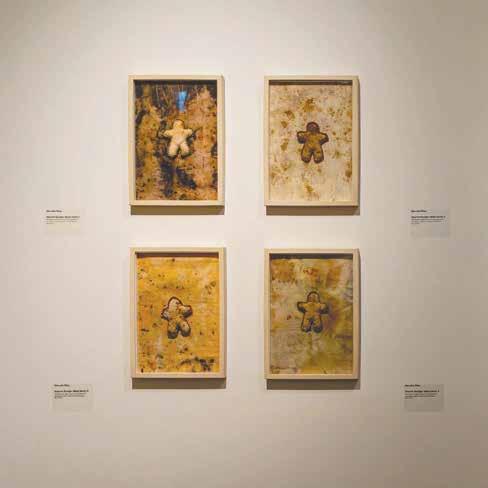

Kwobidak Yorga cont’d.

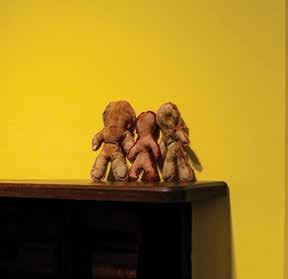

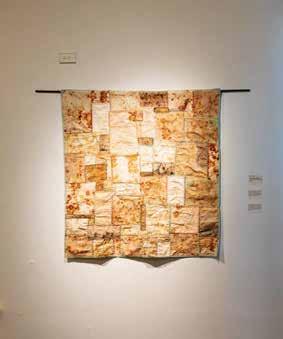

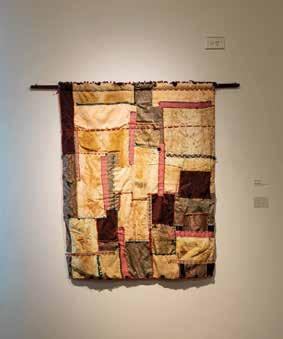
Ngaany Miyal Kwobidak Djinang - My Eyes
See Beauty Photography
Connection to Country is about connection to community, our ancestors and our beautiful land. This connection has a great influence over our happiness, health and wellbeing. Our Wardandi Boodja is seen through our eyes as not just land or a plant. At Djidi Djidi Aboriginal school we are taught the importance of connection. As Djidi Djidi Aboriginal school students we demonstrate our ongoing connection by spending time on country, caring for country and recording our country through our eyes of photography.
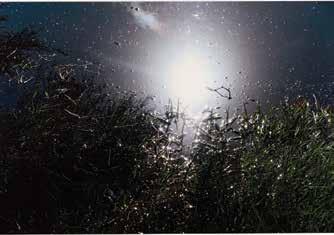
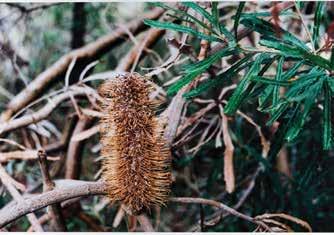
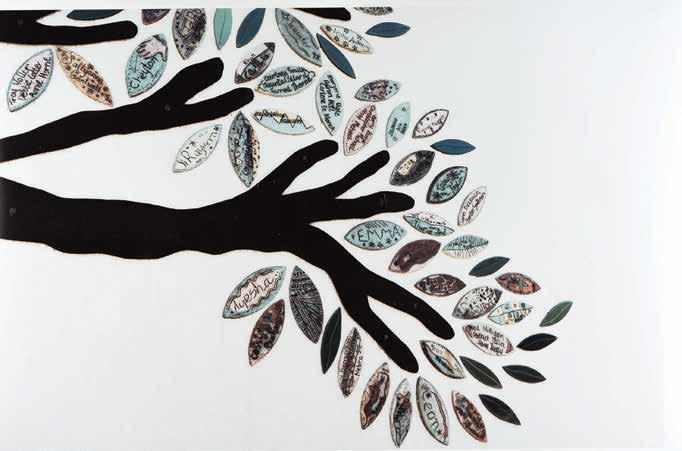

Ngaany Miyal Kwobidak Djinang
- My Eyes See Beauty cont’d.
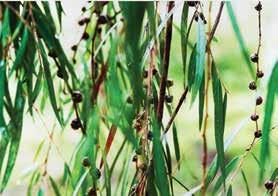
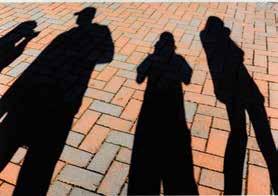

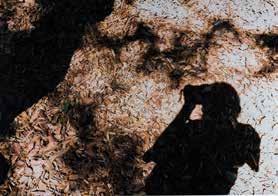
Textiles & Ceramics
This tree was created with Love and in honour of my Mother, who was born on Country and for all the Mothers before who have birthed on Country and those who were born on Country.
Look up and imagine you can hear the wind in the leaves.

After the Rain Installation (Cloth, glass*, earth, bones, teabags, marri gum)
He had to perish for the rest to be.
That cruel man, with his crueler art.
That white insect, bloated with lust and longing and, Violence
No more, in a ceremony that lasted an instant.
They split him apart, great chunks of meat torn from the bone, blood spreading and pooling in a stinking mess of slick red. Then that cruel man, in between worlds, gathered his severed flesh, his brown red blood, and ate himself.
Consumed his flesh, his meat, and shiny off-white bones, his head, cock and fingers, his ribs, liver and spleen. Transformed.
Since before, when the world turned first, and the sky turned again - the old ones, spoke of this day, from the before-days and the ones to come.
Kalyakool boodja
After the rain, we will come, from the fires burning
Kalyakool karla
We are the fire and the smoke and the moorditj women, on the earth strong standing
We see the dry earth, now heaving
When the water rises, flooding
Kalyakool boodja
We are the magic and the makers, the ngaangk and the mid-jal.
We see you, and come for you. We are the revenge and the love and the anger and the knowledge.
We have mourned the empty spaces, and the dry beds.
We see you, and will ask to take your future children. (Not steal, take)
And it will be you that burn and thirst, and heave.

After the rain. Kalyakool
With
Djidi Djidi Djerpin
Acrylic on Canvas
Djidi Djidi Djerpin amongst communities. Willy Wagtails dancing happy ways around the community and surrounding areas.

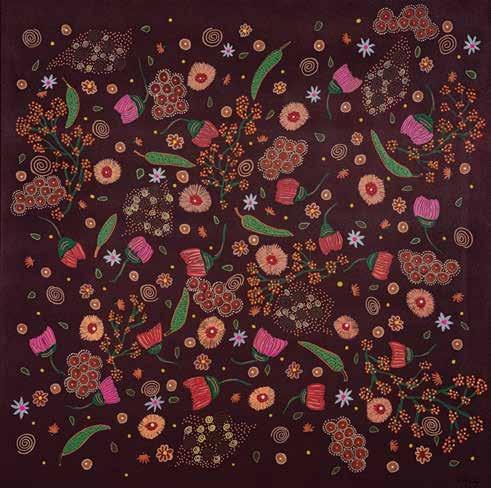
This piece depicts the colourful wildflower season Kambarang. The wide range of colours and shapes in the variety of wildflowers. Visitors from far and wide travel to view this spectacle of nature. At the end of the season, the seeds of the plants fall to the ground or are carried in the wind to grow in another area on country.
Acrylic on Canvas
Glimpses of light
Reflect in me
The light that nourishes
The shadow that hide
No end no beginning
Form and spirit in timeless sleep
Awake in the dreaming
This painting is a collaboration with renowned photographer Christian Fletcher who has a beautiful knack for capturing country with his camera, in this case Purnululu National Park. Though it’s not Noongar country the land is a mirror to ourselves and appreciating, respecting, learning and listening to whatever country we find ourselves standing on, is crucial for the protection and continuous connection to Country and Earth.
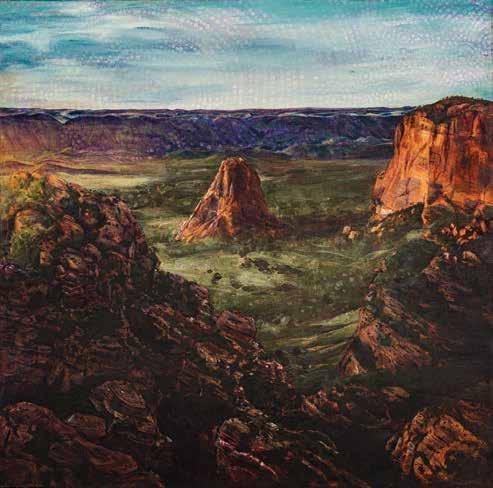
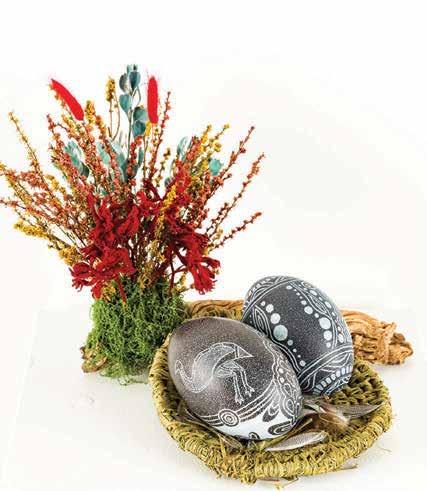
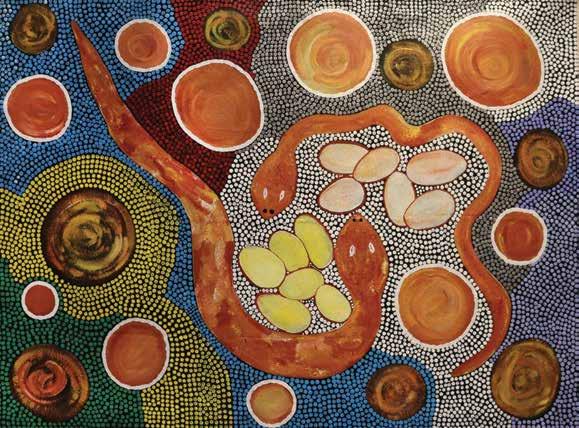
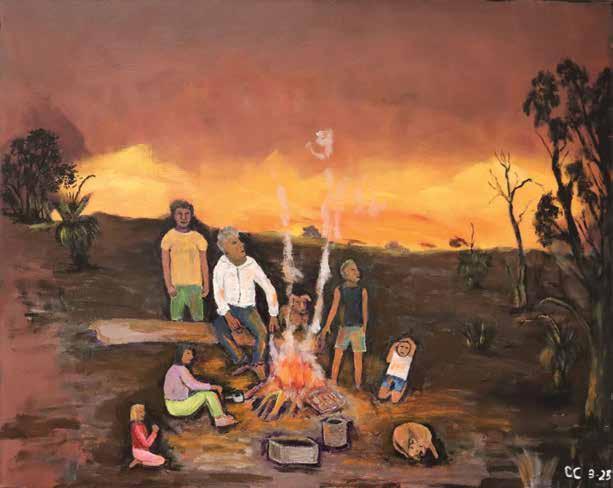
This is the memories of standing and sitting around the fire yarn telling, talking about daily issues or news and for cooking.
In the difficult demanding business of Performing Acts, You are the Crown Jewel of Success, To achieve your level of Success as a Multidimensional Artist is an outstanding measure of your Artistic Talent.
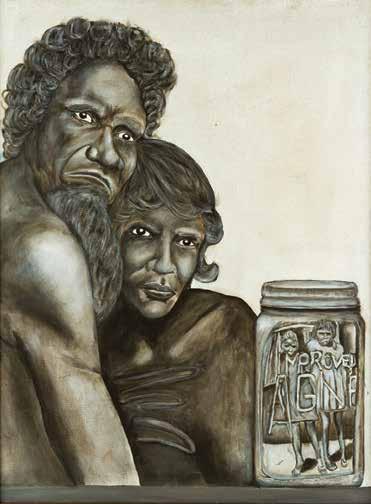

Acrylic on Canvas
This painting was inspired by the landscape of the Southwest where we sit and tell stories to our grandchildren, children and Elders.


Hand Painted Silk
Beautiful Country with our sunsets and landscapes, which our people roamed for many years.
Acrylic on Canvas
This stunning sunset was captured near Bunbury at Myallup, close to the ocean yet in natural bushlands. It is one of my favourite views in Noongar Country.
This reminds me of the many years spent travelling through this area with my family.
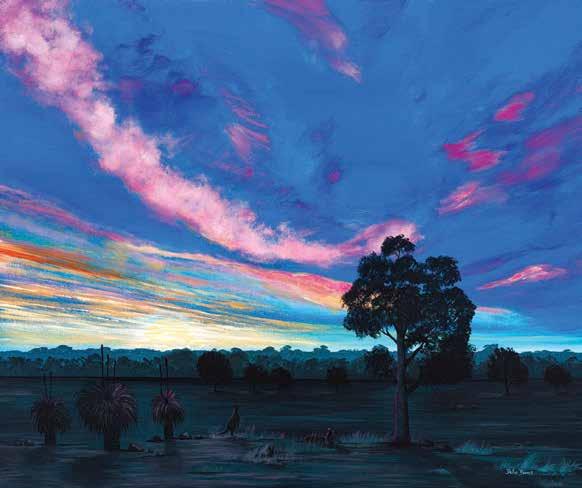
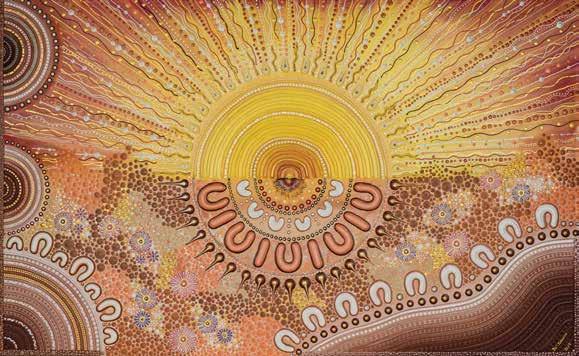
Acrylic Paint & Modelling Paste on Canvas
This painting represents the beautiful sunsets on Noongar country. The sunsets are filled with the most beautiful colours spanning the waters of the west coast.
This is a time when family gathers and catches up, enjoying the afternoon cool breeze.
The colours on the land represent the many wildflowers, the mountains, and community connections.
Acrylic on Canvas
Aboriginal family connections may seem complicated to non-indigenous community. It can seem to be very complex and hard to understand why we call someone uncle or aunty, or sister or brother and we are not even related to the person. It all comes down to respect. Respect for Elders, respect for friends’ family, respect for each other. There might be four, five or more family groups living in a rural town - each having ties to this area, respecting each other, respecting the country, hunting and gathering and sharing together the land we live on.
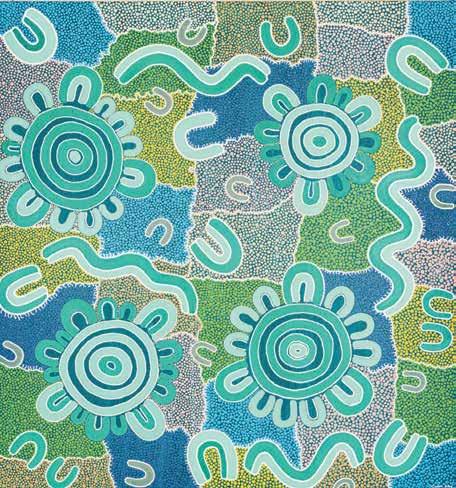
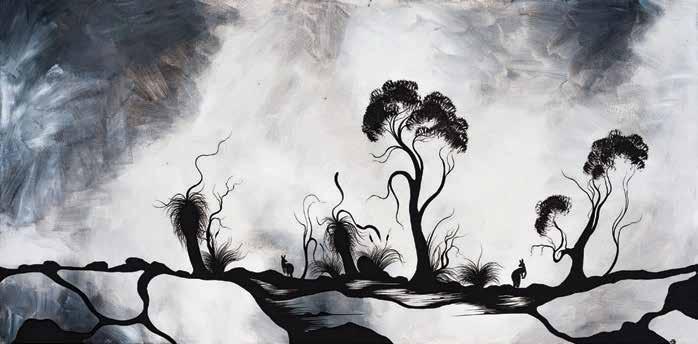
Being a proud Ngadju and Ngaanyatjarra woman, I wanted to acknowledge my grandparents’ country. My Nana, drew Desert Stuart Peas when in the Mount Margaret Mission. I drew 3 Desert Stuart Peas to symbolize my Nana and her family.
My Pop is from Norseman, so I painted the Kangaroo paws that grow around on his country.
Having lived in Bunbury most my life, I painted the Banksia Flower. A strong resilient flower.
I wanted to paint the three native flowers to show because of my grandparents, I am who I am. And the connection we all have to country.


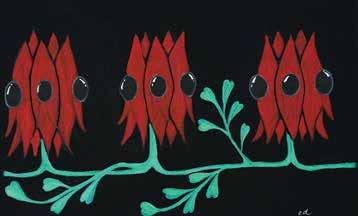

Acrylic on Calico
Belonging on Country
Touch the water
Healing of the water
Connecting to Country Spirit to Country
Blue and white represent water, Country, and the connection.
Acrylic on Canvas
With a large black canvas and a palette of over 30 colours, this piece was created with careful intention, as each colour was chosen and layered in bursts of vibrant energy.
Through bold movement and dynamic layers, this artwork expresses the inner world of a young nonverbal neurodivergent artist. Every splash of colour carries emotion, thought and meaning beyond words, offering a glimpse into a unique perpective.
This piece invites viewers to step into a world where creativity speaks louder than language, revealing the depth, complexity and beauty of self-expression without limits.

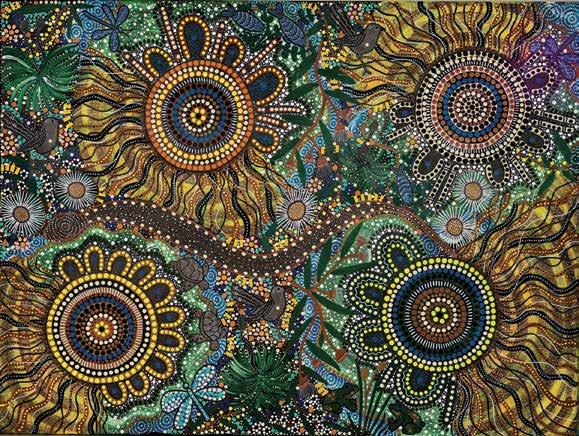
This painting represents Elders, taking the next generations out on country. Learning stories, culture and how to look after country for future generations to come.
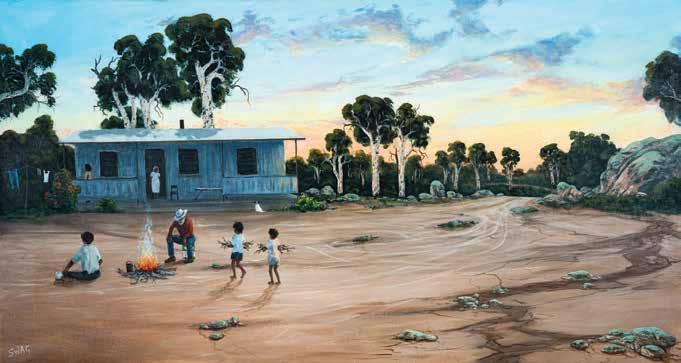
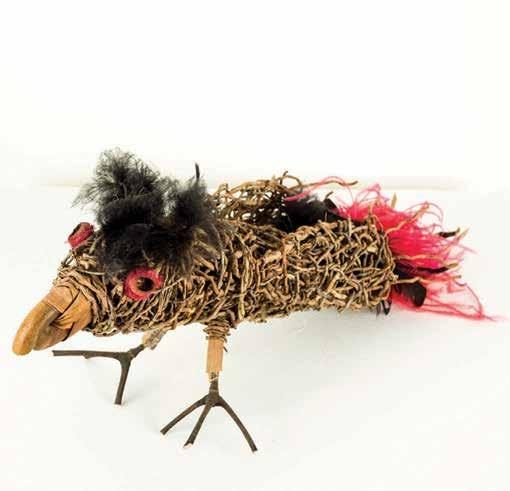
This painting is of my favourite small pink boronias. They only grow in a certain area of the South West of Western Australia, which is very special to know that we have the privilege of seeing these beautiful wildflowers grow. I have many memories of picking and smelling their sweet scent.


Acrylic on Canvas
As cool winds swept accross the coast, bringing heavy rains and swollen rivers, Noongar people knew Mookaroo Bonar had arrived. The ocean waves grew wild, and the sky darkened with thick, rolling clouds. It was time to move inland, away from the rough, stormy waters, to higher ground where the land offered shelter and abundance.
Families travelled together, following the pathways of their old people, to places where the jarrah and marri trees stood tall and strong. This was a sacred time, a time for moort (family) to come together, to share food and stories, and to hand down knowledge.
Sitting around the fire, laughter and songs filled the air as stories of ancestors and spirits were passed down, keeping knowledge alive for the next the generation. Mookaroo was not just a season of rain - it was a season of renewal, of learning, and of deep connection to boodja, moort, and the old ways of the old people.
Installation
Acrylic & Oil on Canvas
Noongar Unavailable, is a work about cultural load. Cultural load; is a term for the ridiculous questions that we are asked about “aborigines”. The term for when you ask me, if it’s politically correct, or if it would be okay with “us”, even if it’s not my Country. It’s the term, you, hold so closely to cultural knowledge. It’s the expectation that we must know, the load. But for me sometimes it’s the words of culture that falls on deaf ears. The price I pay for acts against my people, the price of passing. But god forbid, I don’t know the answer to your stupid question. “Well you must not be that Aboriginal then,” But I am, sorry that the expectation of your ignorance ignores the acts and restrictions of the past.
I am Noongar. But I am trapped in a society where I’m not blak at all, until it’s convenient.
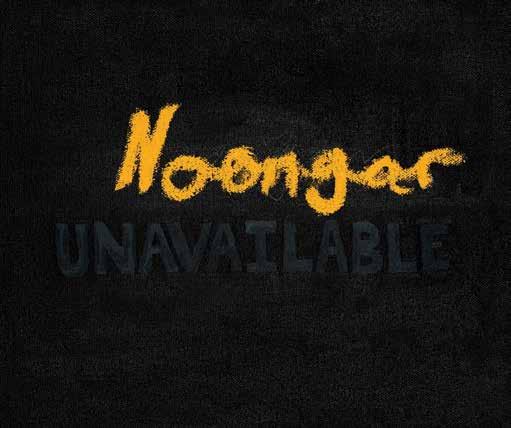
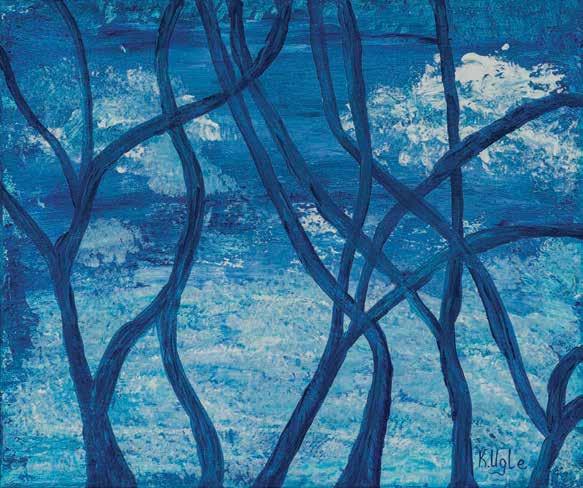
Acrylic on Canvas
Travelling on country watching the trees dancing in the sunlight of the afternoon sun.

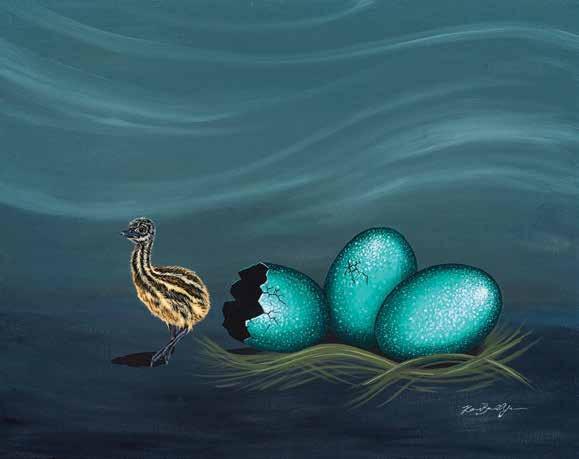
Acrylic on Canvas
Related to 2024 NAIDOC Theme
Keep The Fire Burning BLACK, LOUD & PROUD
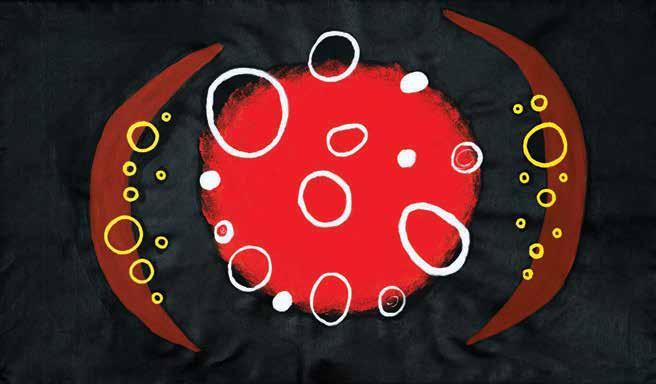
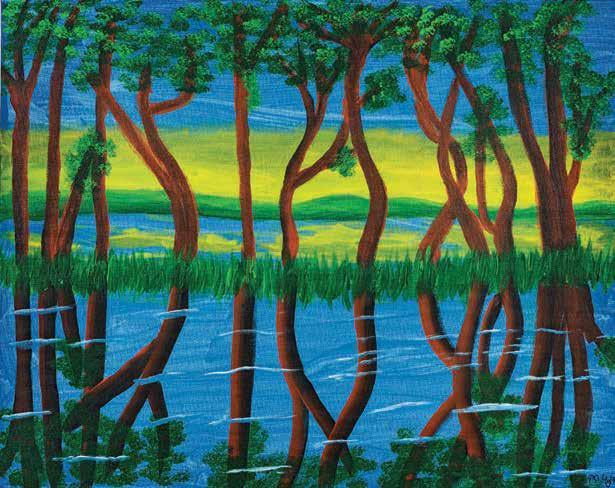
This painting represents the importance of water, land and biodiversity.
Megan Corby
Kep Koort
Acrylic on Stretched Canvas
Kep Koort is my tribute to our beautiful South West region. We are so blessed to live amongst so many breathtaking beaches and pristine fresh Waterways.
As little children we spent so much time enjoying the coastal areas. I loved exploring the basalt rocks and the little creatures that would make them home. The clear sparkling water was always so refreshing and cold.
I believe that growing up around such beauty is a privilege. My love of our beautiful Boodja, in particular our waterways will always be a part of me and something I hold dear to my heart.

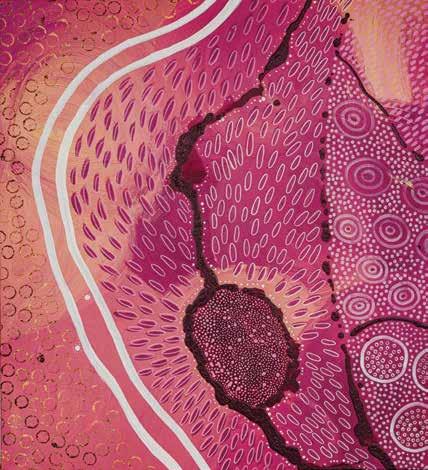
Acrylic on Canvas
My interpretation piece is inspired by the Pink Dangalang (Everlasting) Wildflowers.
Every early Djilba (spring) season, we go out boodjar (bush/land) to visit the Dangalang (everlastings).
There is one particular area that we visit every year, as the bush ground is carpeted with pink dangalangs, we can see the array of pink colour from a distance, and as we get closer to the bush our vision of pure bliss pink dangalangs is a sight for sore eyes, and a sweet aroma of the dangalangs hits our senses that makes memories of a lifetime.
We sit and roll around in the dangalangs out of pure joy. We would be so excited, running around to pluck a few dangalangs to stick behind our ears or a bunch to take home to sit in our table.
Year after year of visiting this place, it still makes us feel special and thankful, especially to God for creating such beauty.
Memories of sitting amongst the dangalangs with our grandmothers, aunties, cousins, sisters and the kids will be remembered forever. And we will continue to visit this place until our last breath... It is very fitting that this piece be called Boordak Boodja (Sweet Pleasant Land).
Acrylic on Canvas
Story from my grandfather, when they used to run away all the time from Roelands Mission. They’d head off just at sunset so they’d get good clearance, they knew the country well, so they had a good idea where to go when it got dark. They’d always get caught a couple of days later and brought back. All they wanted was to be with family.
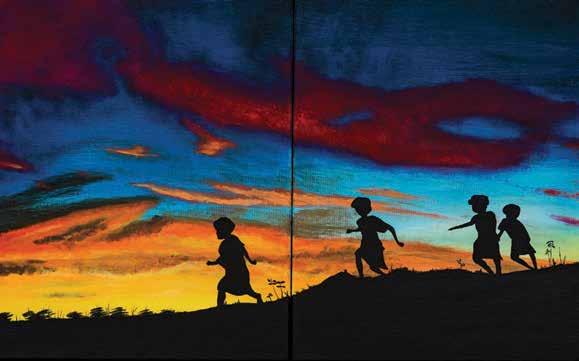

As a kid I grew up watching Carrolup painters. I’ve also been influenced by Carrolup-style painters in prison. I like painting the Great Southern area, mostly Koi Kyeunu-ruff, the Stirling Ranges. Painting gives me some peace, some calm, a chance to escape the troubled world. I believe I’m reconnecting and honouring my ancestors in my Country with my painting. When I paint, I try and show the world through my eyes – how I’m feeling through the expression of paint. I like using bright colours, blending and watching the images form. When I’m not painting, I’m thinking about painting.
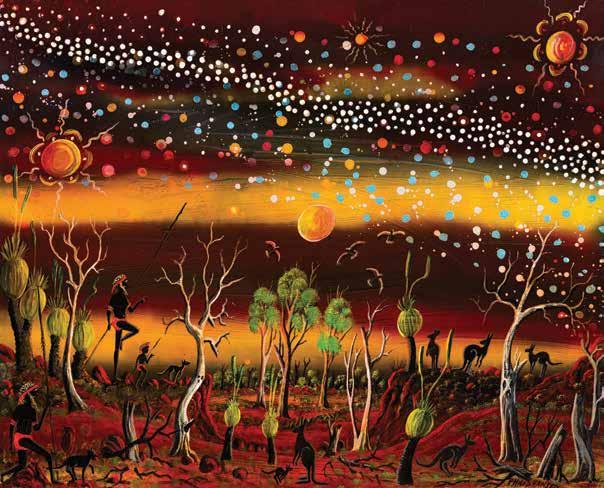
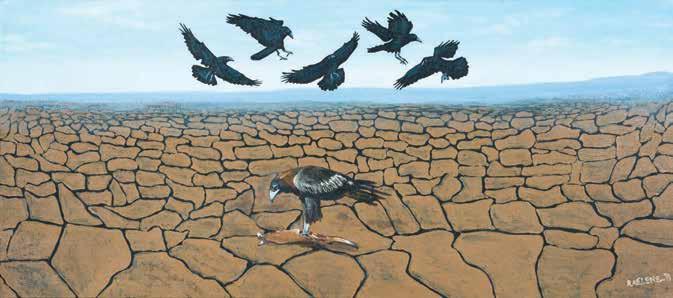
After a well earned soak our outback land dries and cracks under the blue wind swept cloud sky.
Acrylic on Canvas
Djet Wirriny was inspired by Wardandi flowers which symbolise growth and connection to the land. Our culture runs through from the ground to the sky where our spirits look after us.


on Canvas
This art piece is inspired by my grandmother, nana nin, our matriarch. She helped shape and mould me into the woman I am today. She continues to shine and guide us, the next generation, through our storytelling and the handing down of knowledge from her.
In this artwork, she is in the middle, supported by our Elders. Our matriarch embodies resilience, strength, wisdom, and nurturing. She stands as a pillar of our community, of our family—a guardian of knowledge, a teacher who passes down our stories, our traditions, and cultural knowledge. She inspires future generations, fostering a sense of identity, pride, and unity within our community. She is a symbol of continuity and a beacon of hope and empowerment for all who follow in her footsteps.
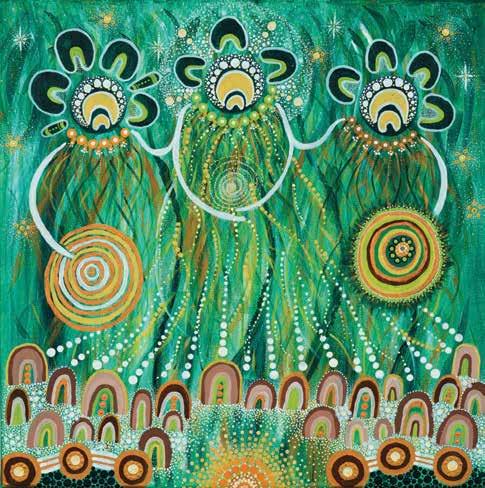

Itsy Bitsy
I was inspired by the vibrant colours of The Australian Peacock spiders. The one depicted is of the Maratus Speciosus species also known as the coastal peacock spider. This spider is only known to be found in the south west of Western Australia.
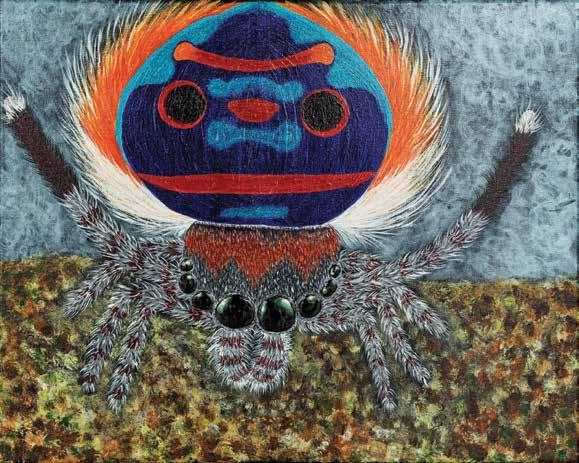
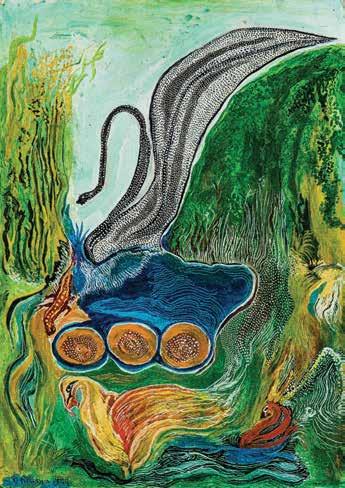
Acrylic on Card
This waterhole is Maali’s camp. He has been away to Capel for the breeding season and now he is back at his camp on the Swan River, with all his friends, the lizards, the other birds, the kangaroos and the water fairy. Everyone is happy to be meeting up again.
This painting is for my granddaughter and her friends - for them to learn how important it is to look after their animals. If we don’t look after Maali’s camp he won’t come back and his friends will move away.
A mother slime and her children were out on a walk when they got attacked by a group of blue slime. The mother slime defends her children the best she could until they went behind the assaulters and oofed them. The mother slime was very proud of her children, they continued their walk like nothing happened.

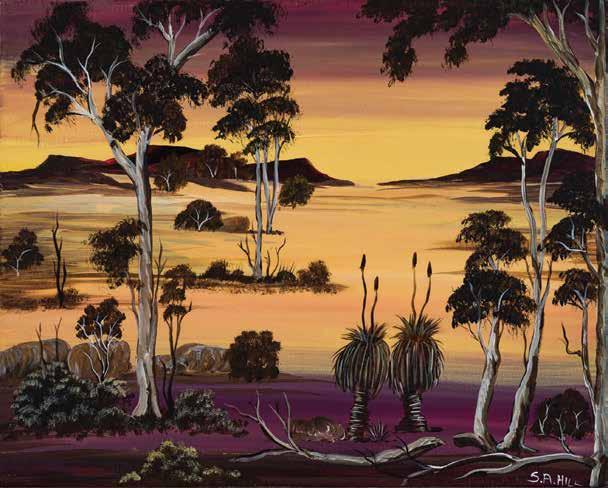
Suspended in stillness, I hold echoes of the land, whispers of the past, and the breath of Country itself. I am more than glass; I am a holder of stories, of moments captured forever, the Country reflected in the sky, the rivers, the wind that moves between the trees and the wind tracks on the water.
Each of us, these delicate orbs, carries the spirit of Country. Hanging in the balance, floating and deeply connected. We are shaped by air, like the first breath of dawn over the rocks, and by fire, like the warmth of the campfire stories passed down through generations. The reflections that shimmer upon us are not just flickers of the present but echoes of ancient footprints, those who walked before, the timeless dance between land, water, and sky.
We are held by invisible threads, much like the unseen but ever-present ties between Country and her people. We do not exist alone; we are connected with each other, with the space, and with those who come to see us. As visitors step close, they see their own image refracted, woven into the songline, this sacred cycle of time. Just as the Country remembers every step taken upon it, we hold each glance, each breath, capturing fleeting moments and making them eternal.
Beneath us, the mirrored surface is not only a reflection. It is a waterhole, a portal to something deeper. It reminds us of the rivers that carve through the earth, the shimmering heat on the horizon, and the way the land holds the stories of those who walk it.
The clustered orbs resting on its surface
resemble a gathering, a yarning circle, a meeting of spirits and ancestors who sit with us - not seen, but always present. They guide, they listen, they share.
Though we are made of glass, we are not fragile. We hold the weight of time, the strength of culture, the breath of Country itself. We remind those who pass through this space that nothing is truly lost, that everything - every moment, every breath, every story - is held within the land. Suspended in air; we are woven into the great, unbroken songline of existence.
And so, we wait, not for an ending, but for the next voice, the next story, the next breath of Country to pass through us and be remembered forever.
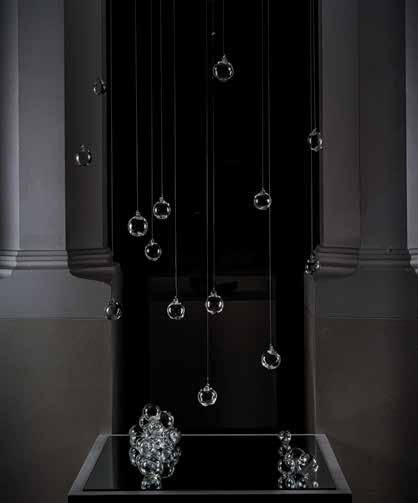
Acrylic on Canvas
This artwork is inspired by keeping the fire burning. Smoke and fires were used for signals for direction and letting mob know they were present in the area when travelling throughout Noongar Boodja. Often, when we burn off, the sky fills with smoke, the sun sets, and the smoke settles. We are left with lines and designs created in the sky by the smoke, with colours of golden yellow from the sun, giving us hints of deep pink and purple with blue as the evening settles in, with stars slowly making an appearance. Connecting us to country with fire from coast to coast, whilst also connecting us with culture—past, present, and future.

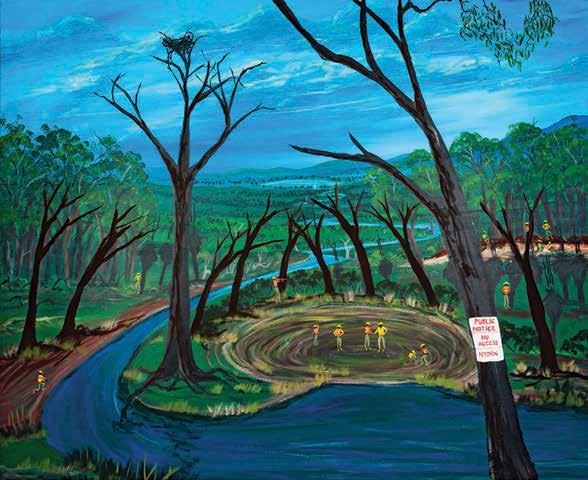
Acrylic on Canvas
This artwork is about Land clearing for progress and highways but there’s always a catch. After the deal is done with anything the High Vis Mob come in and work on Country or damage Country.
Bypass Highways and Minerals are always the thing they do BUT the Land get damaged People complain - The enviroment gets damaged - Dodgy Deals.
No more waterholes - trees and the animals and birds are effected by the damage.
In this picture it is a story about two Yinjibarndi tribal Elders near a place called Millstream Dreaming where my people used to live back in the days. So, two of the wives told their husbands we need bush food and water. So, two of the tribal husbands got together and started singing for rain straight away.
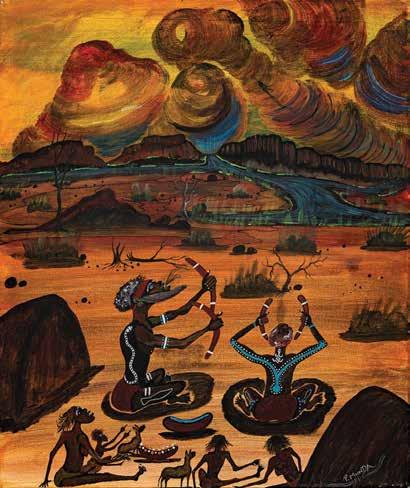

Acrylic on Canvas
When I see something, I can visualise it, or if someone describes land to me, I try and put it together in a landscape. When I start painting, I think of it as an empty box and try to fill it with beautiful things. I started painting in juvie a long time back and now I’m attached to it. Now it takes me to another place and takes away my problems while I’m painting. All these boys who are painting are getting away from hurt for a little while.
Acrylic on Canvas
The turtles are a representation of my mum showing me how to become a woman. Through the different designs of the flippers my family tree is depicted. The turtles are shown swimming upwards to freedom.

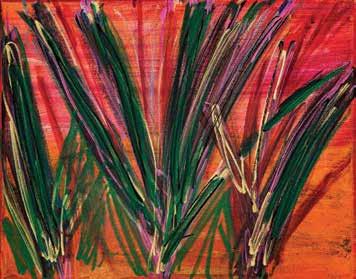
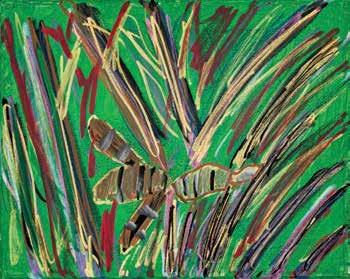
The turtles are a representation of my mum showing me how to become a woman. Through the different designs of the flippers my family tree is depicted. The turtles are shown swimming upwards to freedom.
We are proud to present a selection of Noongar digital films that celebrate the depth of Noongar cultural practice through truthtelling, craft, and design. These short films explore traditional and contemporary expressions, from the intricate art of doll making to the deep connections formed through yarning, the innovation of Noongar fashion design, and the spendlour of the artistic moving image.
By showcasing these works, we aim to highlight the significance of cultural knowledge while inspiring new digital creations for future exhibitions.

Deniseciah
Acrylic on Canvas
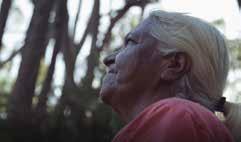
Violet’s Story
Violet Bennell, Troy Bennell, and Richard Bullock
The turtles are a representation of my mum showing me how to become a woman. Through the different designs of the flippers my family tree is depicted. The turtles are shown swimming upwards to freedom.


Dellas Bennell, Rhona Wallam, Dawn Alone, Beverly Thomson, Korrine Bennell, Jo Porter, Lomax Media
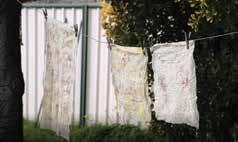
Yarning on Wilmen Boodjar and Traditional Doll Making
Sea Grass & Soft Coral
Acrylic on Canvas
Marcelle Riley and Yolande Ward
Dawn Alone, Amanda Bell, Dellas Bennell, Korrine Bennell, Lera Bennell, Amy Binder, Shannon Clohessy, Scarlett Cumbers, Maya Hume, Candice
Nannup, Rhonda Norman, Violet Coyne, Trish, Bev Thomson, Charlotte
Ugle, Kathy Ugle, Rhona Wallam, Liz Wohlrab, Sue Wohlrab, Nathan
Gardiner, Gaia Boranga, Karen Morgan, Manuao TeAotonga, Ben Yew
Candice Nannup Noongar Country Curator
Anna Edmundson BRAG Team Leader
Dee Mosca BRAG Gallery Officer
Dionne Hooyberg BRAG Registrar
Simon Long BRAG Exhibitions Officer
Molly Werner BRAG Education Officer
Gaia Boranga Noongar Arts Program Coordinator
Ashliegh Hodges Marketing Officer
Payton Mann BRAG Front of House Officer
Michele Laine Gallery Attendant
Paul Robertson Gallery Attendant
Dan Kus Gallery Attendant
Claudia Stiglmayer Gallery Attendant
Victoria Glover Gallery Attendant
Ben Yew Photographer
SW Precision Print Catalogue Design and Print
Korrine Bennell Yarran Brand Design
Bunbury Regional Art Gallery is owned and managed by the City of Bunbury. Government Partners: Department of Local Government, Sport and Cultural Industries (DLGSC), and Department of Infrastructure, Transport, Regional Development, Communications, and the Arts (via IVAIS).
BRAG and the City of Bunbury acknowledge the Wardandi Noongar People as the traditional custodians of the land we are standing on and recognise their continuing connection to the land, waters, and culture. We pay respect to Elders, past, present, and emerging.
The views and opinions expressed in this catalogue are those of the artist and authors and do not necessarily reflect the official position of the Bunbury Regional Art Gallery or its affiliates. Any content provided by the artists or authors are of their opinion are not intended to malign any religion, ethnic groups, organisations or individuals. The stories have been printed verbatim.
Created by local Noongar/Wardandi woman and artist, Korrine Bennell Yarran, the visual identity seen throughout the gallery spaces drew inspiration from the theme of celebration, and ties to what it means for Noongar people to come together with joy, and a strong connection to Country. Korrine’s goal was to create something that feels meaningful, a design that speaks to shared stories, cultural identity, and the beauty of Noongar Art.
Drawing vision from the landscape and natural balance of Country, each element reflects key components of Noongar Boodja and further celebrates the deep connection and ongoing significance. Throughout the design are representations of local flora and fauna —those that are painted, observed, and cherished. They express a love for Country and a celebration of the life it holds.
Korrine’s work is a vibrant expression of culture. It is a celebration of Noongar people, Noongar art, and the deep, enduring connection to boodja.